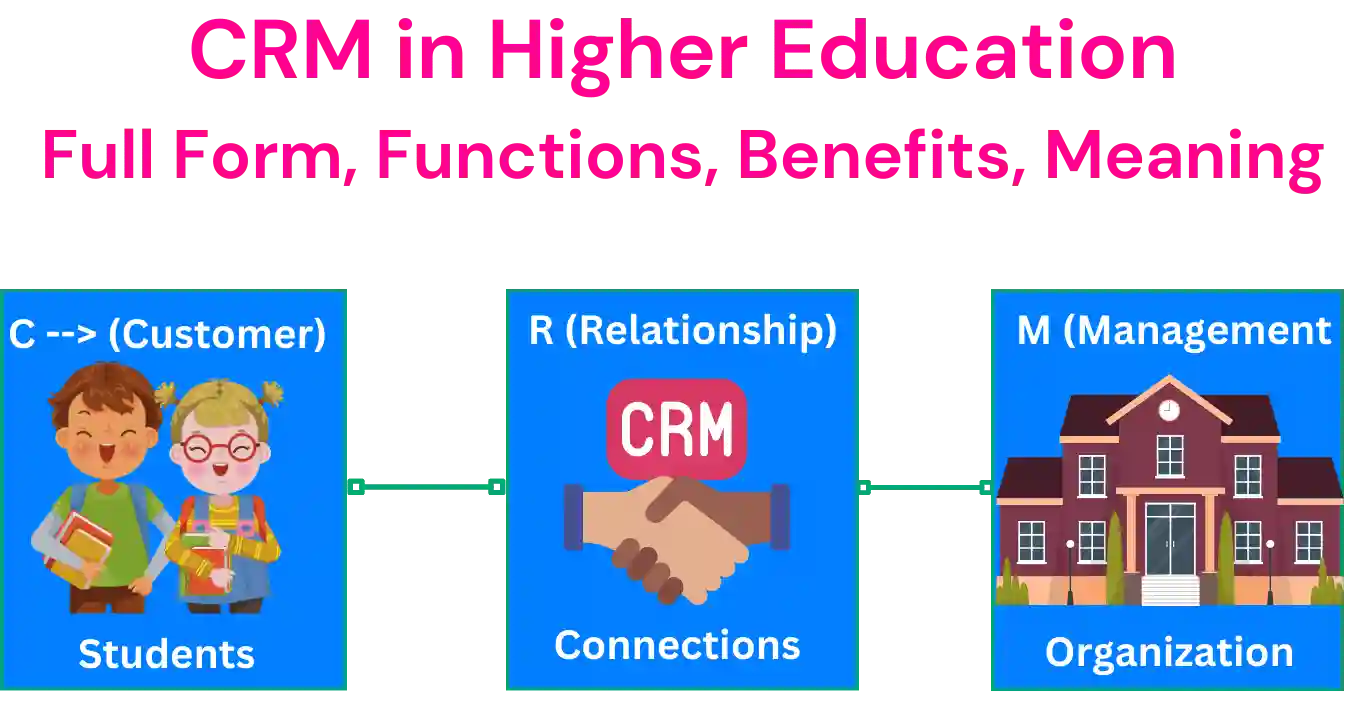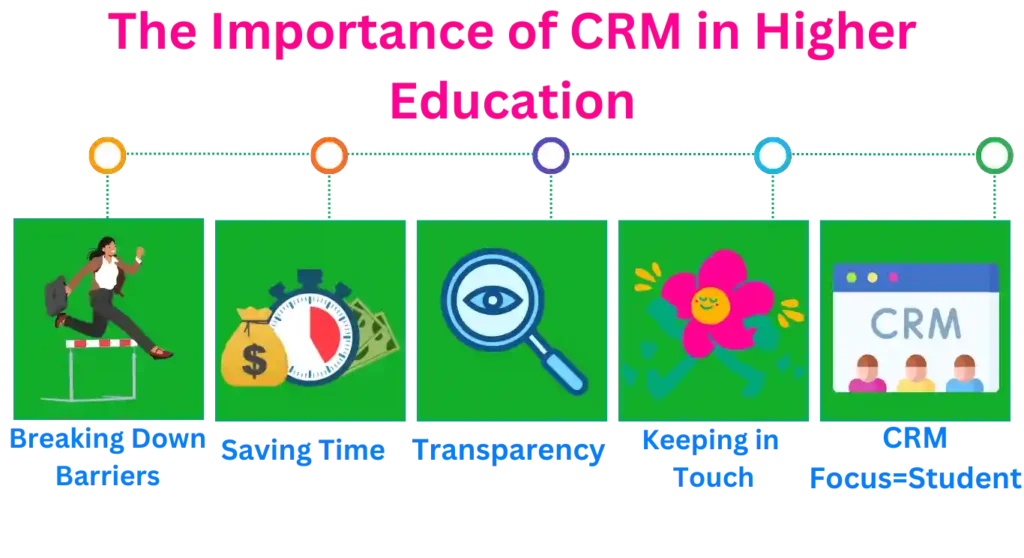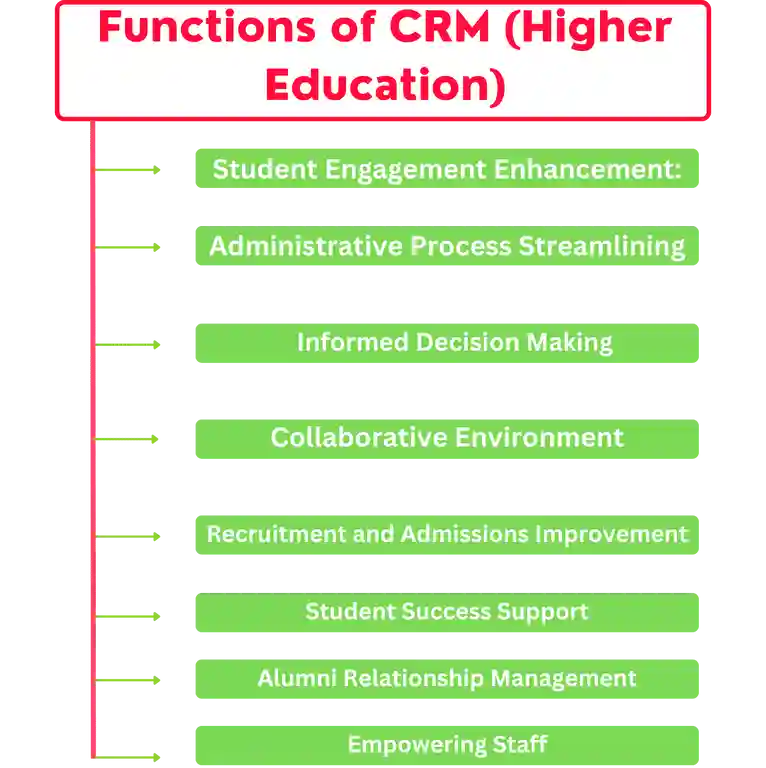CRM stands for Customer Relationship Management utilized by academic institutions to:
- Establish connections with
- Prospective students,
- Former students, particularly sponsors.
It functions as a tool:
- To manage information and interactions.
- Focuses on enhancing academic goals and student success in higher education.
Academic institutions are reimagining their student engagement and administrative methods. They utilize Customer Relationship Management (CRM) systems:
- To streamline processes,
To establish profound connections with:
- Students,
- Alumni,
- Prospects
These systems are crucial, providing:
- Transparency,
- Efficiency,
- Enhanced interaction throughout the institution.
Table of Contents
ToggleKey TakeAways:
- CRM in higher education builds connections with students, alumni, and donors.
- It focuses on managing interactions to boost academic goals and student success.
- CRM involves strategies, tech, plus practices for analyzing interactions.
- Benefits include personalized connections, efficient processes, and smart decision-making.
- Challenges include cost and ensuring data security.
- The future of CRM involves tech advancements like AI and mobile integration.
- It helps in making data-driven decisions and nurturing alumni relationships.
- Modern CRMs suit digital needs and support ongoing student success.
- Picking the right CRM is essential for universities.
- Successful CRM implementation requires planning, stakeholder involvement, and data privacy compliance.
- Real-world success stories demonstrate CRM’s impact on event management, communication, and lead management.
- Benefits of CRM for HEIs encompass admissions management, student inquiries, fee management, and more.
Meaning of CRM in Higher Education

CRM Stands For Customer Relationship Management for higher education which entails:
C -> Customer
- Students (pupils), alumni, plus donors are the “Customers” in higher education emphasizing CRM in higher education.
- Students drive university activities by enrolling, participating, collaboration & contributing.
- Alumni maintain ties, offering ongoing support, and advocacy.
- Donors contribute financially to diverse university initiatives.
R -> Relationship
- “Relationship” signifies ongoing engagements b/w universities and stakeholders particularly relevant in CRM in higher education.
- It involves nurturing lasting connections beyond a students tenure.
- Strong relationships foster loyalty, support and a sense of community.
M -> Management
- “Management” denotes strategic oversight in nurturing these connections, especially significant in CRM in higher education.
- It includes planning, coordination and plus implementing strategies, rules, instructions using CRM systems.
- The aim is to optimize interactions, track engagement, and plus personalize communications.
What is a CRM system in higher education?
CRM Full Form Customer Relationship Management is Refers to:
- Strategies,
- Technologies,
- Practices that organizations, including universities, employ to manage and analyze interactions with students, alumni, and donors throughout their lifecycle.
It involves using data analysis about customer interactions to:
- Improve relationships,
- Boost retention,
- Drive sales growth.
What CRM Does in Higher Education:
- Personalized Connections: CRM assists universities in tailoring communications and support for students based on their individual needs and plus interests, fostering a more personal approach or ways.
- Efficient Processes: It streamlines tasks such as admissions and scheduling through automation, simplifying and expediting administrative procedures.
- Smart Decision-Making: By gathering information about students, alumni, and plus donors, universities can formulate more informed plans and decisions leveraging data for strategic purposes.
- Teamwork: CRM breaks down silos between university departments, promoting collaboration and ensuring everyone is aligned and informed about student-related matters, fostering a more unified approach.
How CRM Helps Universities:
- Recruitment and Admissions: CRM aids universities in identifying students requiring additional support and in diversifying their student body enhancing recruitment and plus admissions processes.
- Student Success: It supports struggling students, increasing the likelihood of their retention and success throughout their college journey.
- Connecting with Alumni: Universities utilize CRM to maintain contact with former students, fostering donations and cultivating a robust community network.
- Making Better Choices: CRM data empowers universities to enhance planning, optimize resource utilization, and adapt efficiently to evolving circumstances, enabling smarter decision-making.
Challenges and Solutions:
- Cost: CRM systems can be costly, but universities can seek favorable deals with suitable partners.
- Data Security: Safeguarding student information is crucial; universities train staff to safely utilize CRM systems.
Future of CRM in Higher Education:
- Tech Improvements: CRM systems are advancing, becoming more user-friendly, and integrating with innovative technologies like AI and big data.
- Trends Shaping CRM: AI personalizes student interactions, big data aids in understanding student needs, and mobile CRM enhances accessibility.
Benefits of CRM for Universities:
- One View for All Info: CRM consolidates scattered data, providing a unified platform for informed decision-making.
- Cost Savings: Utilizing a single system instead of multiple ones saves money in the long term.
- Better Student Experience: CRM systems offer enhanced help and support to students.
- Empowering Staff: Staff can work more efficiently and effectively with the aid of CRM.
- Adapting to Changes: CRM systems assist universities in swiftly adjusting to new methodologies.
Success Stories Using CRM:
- University of Kentucky: Provided quick support to students during the pandemic by promptly contacting and assisting them.
- Hennepin Technical College: Enhanced student enrollment by employing CRM for improved processes.
- Institut Químic de Sarrià (IQS): Leveraged CRM to refine operations and decision-making based on student interactions.
The Importance of CRM in Higher Education

CRM focuses on creating connections not just about data or figures. It provides employees with a comprehensive departmental perspective enabling them to make better decisions as well as enhance the educational experience for students or learners. Here are a few advantages (benefits):
Breaking Down Barriers:
It gets rid of data barriers so every department can use the same student info to provide unified support.
For Example: The CRM system in a university breaks down data barriers b/w departments. The admissions team, academic advisors, and student services can access the same student information. This unified data access allows them to provide consistent and tailored support to students throughout their academic journey.
Saving Time:
CRM systems handle tasks letting staff focus on meaningful interactions instead.
Consider a scenario where the CRM system automates routine tasks like sending reminders for fee payments or course registrations. This automation frees up staff time enabling them to engage in personalized the interactions with students, offering guidance, as well as addressing specific concerns promptly.
Transparency:
Real-time data clears things up guiding decisions that affect the whole university.
In a university setting, a CRM system provides real time insights into student engagement plus performance. This transparency aids in making informed decisions about resource allocation, course offerings and support services based on current the student needs, requirements and trends.
Keeping in Touch:
It is a central spot for managing the student communication making sure important messages reach students or learners on the time.
For Example: The CRM system managing student communication efficiently. It ensures that crucial updates, event notifications, or academic advisories reach students promptly through their preferred communication channels fostering a more engaged and informed student community.
Functions of CRM (Higher Education)

The functions of CRM in higher education encompass several key and important aspects:
- Student Engagement Enhancement: CRM systems facilitate personalized communication, support and as well as guidance for students (pupils) tailoring interactions to individual needs plus interests.
- Administrative Process Streamlining: Automation through CRM simplifies administrative tasks like admissions, scheduling, and documentation, making procedures more efficient.
- Informed Decision Making: By gathering and analyzing data on students, alumni plus donors and universities can make data driven decisions to optimize resources and strategies.
- Collaborative Environment: CRM breaks down departmental silos, promoting collaboration among university units ensuring alignment and coherence in dealing with student related matters aur stuff.
- Recruitment and Admissions Improvement: CRM assists in identifying students who require additional support diversifying student bodies and refining recruitment and admissions processes.
- Student Success Support: It aids struggling students contributing to higher retention rates plus as well as fostering success throughout their academic journey.
- Alumni Relationship Management: Universities leverage CRM to maintain connections with former students, fostering donations and cultivating a robust community network.
- Empowering Staff: CRM enables staff to work more efficiently and effectively, utilizing data and streamlined processes to enhance support and services for students.
Leveraging CRM in Higher Education:
Building Meaningful Relationships:
- First Day to Alumni: CRM helps in establishing connections right from a students first day on campus and plus nurtures ongoing engagement even after graduation fostering lasting relationships with alumni.
Data-Driven Decision Making:
- Strategic Insights: CRM provides valuable insights crucial for making strategic decisions implementing technological advancements as well as designings effective enrollment campaigns based on data analysis.
Alumni Engagement:
- Community Bond: CRM systems aids in maintaining connections with former students ensuring their continued engagement. This fosters the strong sense of community among alumni promoting involvement and support for the institution.
How CRM Helps Students Stay Connected
Modern CRMs Go Beyond Prospective Students:
- Adapting to Digital Needs: Updated CRMs are not just for new students. They have changed to suit the digital needs of current students too.
Why CRM is Great for Students:
- Helps Students Along the Way: It keeps track of important steps and helps more students stay in school.
- Makes School Better: It gives the advice and help when needed especially for students who find things hard and it makes messages feel personal.
Choosing the Right CRM:
- Picking the Best CRM: Looking at good CRM programs made for schools ones that fit the plan and the budget.
Best CRM Platforms for Higher Education
- Element451: Focuses on personalized digital experiences and engagement, offering an intuitive platform for CRM in Higher Education.
- Slate CRM: Tailored for admissions professionals, equipped with robust document management and communication tools, ideal for CRM in Higher Education.
- TargetX: Offers a comprehensive solution for managing the student lifecycle, enhancing community, and providing valuable insights, beneficial for CRM in Higher Education.
- Salesforce (Education Cloud): Renowned for its Education Data Architecture and seamless connectivity.
- Zendesk: Simplifies operations, particularly useful in the current landscape of remote learning.
- Zoho CRM: An affordable option known for its simplicity and user-friendly interface.
- Keap: Ideal for managing outreach, recruitment, and enrollment, focusing on conversion.
- NetSuite CRM: Provides advanced solutions for scalable student data management.
- Hubspot: Offers a free, comprehensive CRM platform suitable for real-time customer data.
- Pipedrive: User-friendly and sales-oriented, beneficial for admissions and revenue channels.
- Ellucian CRM: Specialized for colleges, streamlining workflows and increasing engagement.
- Embark Campus: Focuses on recruitment and collaboration, simplifying application management.
- Maestro Student Information System: Streamlines document management, particularly beneficial for blended learning environments.
- Creatrix Campus: Integrates AI, enhancing student management and faculty excellence.
These platforms offer a variety of features and functionalities tailored to support the specific needs of CRM in higher education institutions.
Implementing CRM:
- Implementing a CRM requires planning and strategy:
- Involving stakeholders at every level for buy in plus clear expectations.
- Ensuring secure & compliant solutions for student’s data privacy.
- Training and setting standards for efficient use across departments.
- Establishing continuous improvement plans for ongoing success.
Real-World Success with CRM in Universities
Insights from educators utilizing CRM systems underscore their effectiveness:
- Westminster University Event Management: Improved user experience & streamlined data processes post event.
- Stockholm School of Economics’ Targeted Communication: Enhanced audience focus personalized content and engagement tracking for efficient and with great message delivery.
- BTK University of Applied Sciences Lead Management: Efficiently manages prospectives students plus adapts marketing strategies based on reporting insights.
The Benefits: CRM for HEIs
- Admissions Management: Streamlining the student admissions lifecycle: managing program details academic documents and essential tasks.
- Lead Tracking: Integrated tracking tools identify student sources, refining marketing campaigns and resource allocation.
- Student Inquiries Handling: Ensuring seamless communication and follow-ups during the counseling process.
- Teacher Evaluations and Career Processes: Streamlining teacher certification and career-related processes for efficiency.
- Fee Management and Alumni Relations: Automating fee payment processes and nurturing long lasting alumni relations for invaluable support and plus networking opportunities.
- Student Lifecycle Management: Comprehensive lifecycle management from enrollment to alumni engagement ensuring personalized interactions across touchpoints.
People Also Read:
Exploring Countries That Start With D: Global Adventure
FAQs- About CRM in Higher Education
What is a CRM system in higher education?
A CRM system helps universities keep track of their connections with students (educators), alumni and donors. It is like a special computer program that organizes the information, handles tasks and plus follows progress.
What is the importance of CRM in university?
CRM is essential in educational environments because it helps in:
- Keeping pupils interested and in class
- Building better relationships with alumni
- Utilizing data to guide wise decisions
- Making administrative work smoother
What is CRM in admission?
CRM helps universities in handling tasks such as:
- Monitoring prospective pupils
- Managing applications
- Speaking with potential candidates
- Choosing the recipients of acceptance
How does CRM benefit an academic environment?
CRM is beneficial in a variety of ways including:
- Enhancing correspondence between staff and students
- Offering personalized help to students
- Identifying students who might need extra support early on
- Tracking how well students are doing
What is CRM and examples?
CRM means managing relationships with technology. Examples include special software like Salesforce or HubSpot that track interactions and manage data.
What is the top main purpose of the CRM system?
CRM systems help businesses handle their interactions with customers, making them happier, increasing sales, and cutting costs.
What are the main benefits or advantages of CRM?
Using CRM brings lots of good things, like happier customers, more sales, lower costs, better communication, and as well as doing things more efficiently.
What are CRM strategies?
CRM strategies are plans to make CRM work. They might include sorting customers personalizing things automating tasks, and plus using data.
What are the key elements of CRM?
The important parts of CRM are data, technology, processes, and people.
What is CRM in full form?
CRM stands for Customer Relationship Management.
Who is eligible for CRM?
CRM is applicable to all businesses, firms, regardless of size, who communicate and interact with customers.
What is the difference between CRM and student management system?
A student management system (SMS- Student Management System) handles student records while CRM deals with interactions between students, alumni and as well as the institution.
How will CRM help in the future?
In the future CRM will be even more important using advanced tech like AI to personalize interactions and make decisions based on data.